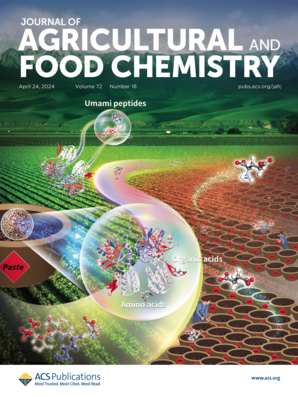外源应用功能代谢物迷迭香酸可以模拟AMF接种对植物生长促进和Cd钝化的作用。
IF 6.2
1区 农林科学
Q1 AGRICULTURE, MULTIDISCIPLINARY
引用次数: 0
摘要
先前的研究表明,接种Glomus mosseae (AMF)显著增加了Cd敏感苜蓿的生物量,降低了镉(Cd)的积累,这与AMF诱导的根分泌物招募了富含植物生长促进菌和Cd钝化菌的功能微生物群有关。在此,我们通过微观环境和温室盆栽试验,确定了增强α多样性和功能潜力的关键代谢物,并评估了它们的外源应用效应。基于生长促进菌群和cd钝化菌群的α多样性和功能分析,microcosmic筛选鉴定出迷迭香酸、肉豆蔻酸和吲哚-3-乙酸(IAA)是关键的功能代谢物。温室试验表明,这三种代谢物均显著增加了植物生物量(迷迭香酸:28.8%;肉豆蔻酸:35.8%;IAA: 22.2%;P < 0.05)。然而,只有迷迭香酸显著降低了根际Cd有效性(14.4%,P < 0.05),其效果与接种AMF相当(P < 0.05)。单株招募实验进一步证实迷迭香酸具有较强的功能菌富集能力,具有较强的趋化性和生物膜形成能力。本文章由计算机程序翻译,如有差异,请以英文原文为准。
Exogenous Application of the Functional Metabolite Rosmarinic Acid Can Simulate the Effects of AMF Inoculation on Plant Growth Promotion and Cd Passivation.
Previous studies revealed that inoculation with Glomus mosseae (AMF) significantly increased biomass and reduced cadmium (Cd) accumulation in Cd-sensitive Medicago sativa, which was linked to AMF-induced root exudates recruiting a functional microbiome enriched with plant growth-promoting and Cd-passivating bacteria. Here, we employed microcosm and greenhouse pot experiments to identify key metabolites that enhance the α diversity and functional potential of this microbiome and evaluated their exogenous application effects. Microcosm screening, based on α diversity and functional profiling of growth-promoting and Cd-passivating bacterial communities, identified rosmarinic acid, myristic acid, and indole-3-acetic acid (IAA) as critical functional metabolites. Greenhouse experiments demonstrated that all three metabolites significantly increased plant biomass (rosmarinic acid: 28.8%; myristic acid: 35.8%; IAA: 22.2%; P < 0.05) compared to the control. However, only rosmarinic acid significantly reduced rhizosphere Cd availability (14.4%, P < 0.05), with effects comparable to AMF inoculation (P > 0.05). Single-strain recruitment assays further confirmed that rosmarinic acid exhibited superior capability in enriching functional bacteria, demonstrating stronger chemotaxis and biofilm formation abilities.
求助全文
通过发布文献求助,成功后即可免费获取论文全文。
去求助
来源期刊
CiteScore
9.90
自引率
8.20%
发文量
1375
审稿时长
2.3 months
期刊介绍:
The Journal of Agricultural and Food Chemistry publishes high-quality, cutting edge original research representing complete studies and research advances dealing with the chemistry and biochemistry of agriculture and food. The Journal also encourages papers with chemistry and/or biochemistry as a major component combined with biological/sensory/nutritional/toxicological evaluation related to agriculture and/or food.

 求助内容:
求助内容: 应助结果提醒方式:
应助结果提醒方式:


